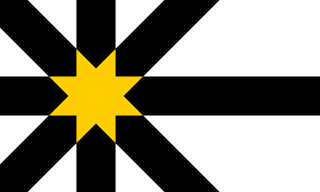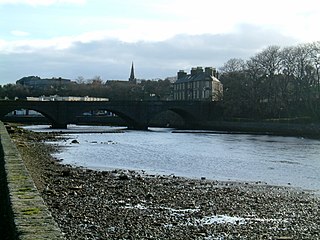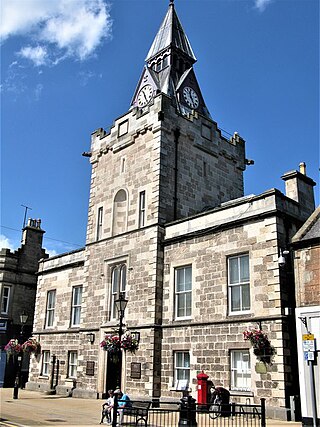
Highland is a council area in the Scottish Highlands and is the largest local government area in the United Kingdom. It was the 7th most populous council area in Scotland at the 2011 census. It has land borders with the council areas of Aberdeenshire, Argyll and Bute, Moray and Perth and Kinross. The wider upland area of the Scottish Highlands after which the council area is named extends beyond the Highland council area into all the neighbouring council areas plus Angus and Stirling.

Thurso is a town and former burgh on the north coast of the Highland council area of Scotland. Situated in the historical County of Caithness, it is the northernmost town on the island of Great Britain. From a latitudinal standpoint, Thurso is located further north than the southernmost point of Norway and in addition lies more than 500 miles (800 km) north of London.

Sutherland is a historic county, registration county and lieutenancy area in the Highlands of Scotland. The name dates from the Viking era when the area was ruled by the Jarl of Orkney; although Sutherland includes some of the northernmost land on the island of Great Britain, it was called Suðrland from the standpoint of Orkney and Caithness.

Caithness is a historic county, registration county and lieutenancy area of Scotland.

Wick is a town and royal burgh in Caithness, in the far north of Scotland. The town straddles the River Wick and extends along both sides of Wick Bay. "Wick Locality" had a population of 6,954 at the time of the 2011 census, a decrease of 3.8% from 2001.

Watten is a small village in Caithness, in the Highland area of Scotland, on the main road (A882-A9) between the burgh of Wick and the town of Thurso, about twelve kilometres west of Wick and close to Wick River and to Loch Watten. The village is on The Far North railway line but trains stopped calling at the village in 1960. The railway station is now a private house.
A county hall or shire hall is a common name given to a building that houses the seat of local government for a county.

Georgemas Junction railway station is a railway station located in the Highland council area in the far north of Scotland. It serves several rural hamlets in the historic county of Caithness, including Georgemas, Roadside and Banniskirk. It is also the nearest station to the village of Halkirk, which lies approximately 1.6 miles (2.6 km) west of the station.

Wick railway station is a railway station located in Wick, in the Highland council area in the far north of Scotland. It serves the town of Wick and other surrounding areas in the historic county of Caithness, including Staxigoe, Papigoe and Haster. The station is the terminus of the Far North Line, 161 miles 36 chains from Inverness. It is managed by ScotRail, who operate all trains serving the station.

The Wick and Lybster Light Railway was a light railway opened in 1903, with the intention of opening up the fishing port of Lybster, in Caithness, Scotland, to the railway network at Wick. Its construction was heavily supported financially by local government and the Treasury. It was worked by the Highland Railway.

The Highland Council is the local authority for Highland, one of the 32 council areas of Scotland. The council is based at the Highland Council Headquarters in Inverness.
North of Scotland Newspapers (NOSN) is the trade name under which Scottish Provincial Press publishes two weekly newspapers, the John O'Groat Journal and the Caithness Courier, both serving the Caithness area in the Highland council area of Scotland. The two papers share one website.

Inverness-shire or the County of Inverness, is a historic county in Scotland. It is named after Inverness, its largest settlement, which was also the county town. Covering much of the Highlands and some of the Hebrides, it is Scotland's largest county by land area. It is generally rural and sparsely populated, containing only three towns which held burgh status, being Inverness, Fort William and Kingussie. The county is crossed by the Great Glen, which contains Loch Ness and separates the Grampian Mountains to the south-east from the Northwest Highlands. The county also includes Ben Nevis, the highest mountain in both Scotland and the United Kingdom.

The Caithness flag is the flag of the county of Caithness. It was registered with the Flag Institute as the official flag of the county in 2016. The flag was adopted following a competition arranged by the Highland Council. It was unveiled by the Lord Lyon, Dr Joseph Morrow, at a ceremony in Caithness House, Wick on 26 January 2016. The Nordic cross design symbolises the ancient ties of the county to the Vikings. The black recalls the county's geology with the famous Caithness flagstone, while the gold and blue allude to the beaches and sea reinforcing the maritime nature of the county and its heritage. The traditional emblem of Caithness, a galley, is placed in the first quarter, with a raven upon its sail as it appears in the county's civic arms.

Gail Elizabeth Ross is a former Scottish National Party (SNP) politician, who served as the Member of the Scottish Parliament (MSP) for Caithness, Sutherland and Ross from the election in May 2016 up until 2021 when she decided to not seek re-election. She was a councillor on the Highland Council 2011–2016, and civic leader of Caithness 2012–2016.

Perth Sheriff Court is an historic building on Tay Street in Perth, Perth and Kinross, Scotland. The structure, which is used as the main courthouse for the area, is a Category A listed building.

Nairn Town and County Buildings is a municipal structure in the High Street, Nairn, Highland, Scotland. The structure, which is used as a service point for The Highland Council, is a Category B listed building.

Wick Town Hall is a municipal building in Bridge Street, Wick, in the Highland area of Scotland. The structure, which is used as a community events venue, is a Category B listed building. It formerly served as the meeting place of both Wick Town Council and Caithness County Council.

Wick Sheriff Court is a judicial structure in Bridge Street, Wick, Caithness, Scotland. The structure, which remains in use as a courthouse, is a Category B listed building.

County Offices is a former municipal building on Main Street in Golspie in Scotland. The building, which used to be the headquarters of Sutherland County Council, is now divided into seven residential properties known as 1-7 The Old Post Office.


















